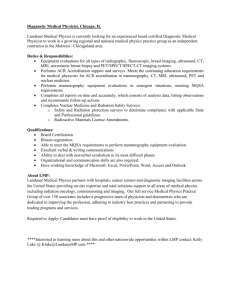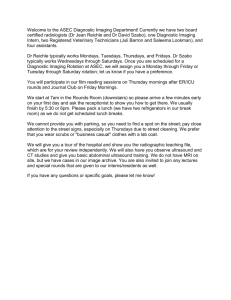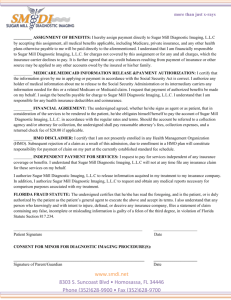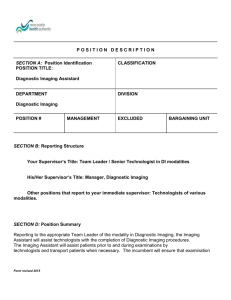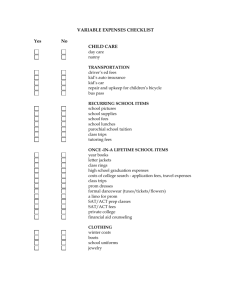Access to Medical Services
advertisement
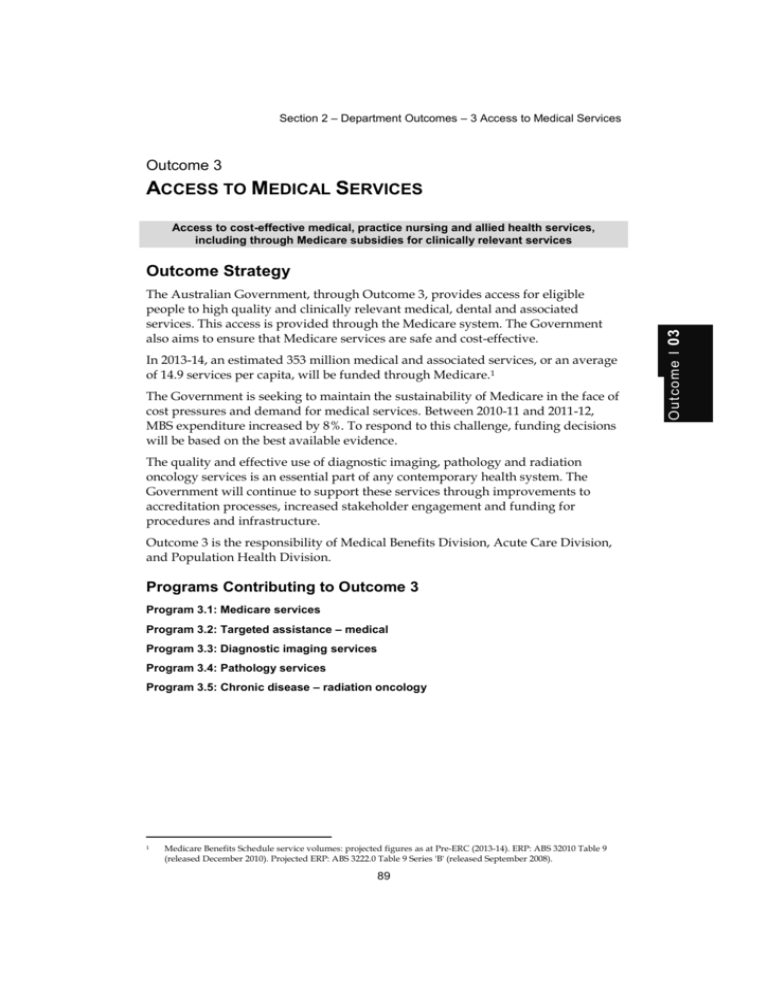
Section 2 – Department Outcomes – 3 Access to Medical Services Outcome 3 ACCESS TO MEDICAL SERVICES Access to cost-effective medical, practice nursing and allied health services, including through Medicare subsidies for clinically relevant services The Australian Government, through Outcome 3, provides access for eligible people to high quality and clinically relevant medical, dental and associated services. This access is provided through the Medicare system. The Government also aims to ensure that Medicare services are safe and cost-effective. In 2013-14, an estimated 353 million medical and associated services, or an average of 14.9 services per capita, will be funded through Medicare.1 The Government is seeking to maintain the sustainability of Medicare in the face of cost pressures and demand for medical services. Between 2010-11 and 2011-12, MBS expenditure increased by 8%. To respond to this challenge, funding decisions will be based on the best available evidence. The quality and effective use of diagnostic imaging, pathology and radiation oncology services is an essential part of any contemporary health system. The Government will continue to support these services through improvements to accreditation processes, increased stakeholder engagement and funding for procedures and infrastructure. Outcome 3 is the responsibility of Medical Benefits Division, Acute Care Division, and Population Health Division. Programs Contributing to Outcome 3 Program 3.1: Medicare services Program 3.2: Targeted assistance – medical Program 3.3: Diagnostic imaging services Program 3.4: Pathology services Program 3.5: Chronic disease – radiation oncology 1 Medicare Benefits Schedule service volumes: projected figures as at Pre-ERC (2013-14). ERP: ABS 32010 Table 9 (released December 2010). Projected ERP: ABS 3222.0 Table 9 Series 'B' (released September 2008). 89 Outcome I 03 Outcome Strategy Budget Statements – Department of Health and Ageing Outcome 3 Budgeted Expenses and Resources Table 3.1 provides an overview of the total expenses for Outcome 3 by program. Table 3.1: Budgeted Expenses and Resources for Outcome 3 2012-13 Estimated actual $'000 2013-14 Estimated expenses $'000 6,078 9,509 83,087 18,459,874 244,034 18,838,215 28,880 846 29,318 1,143 18,578,765 19,122,219 31,292 41,223 1,399 38 1,243 52 32,729 42,518 3,349 3,370 629 17 559 23 3,995 3,952 Administered expenses Ordinary annual services (Appropriation Bill No. 1) 4,738 4,287 Departmental expenses Departmental appropriation1 Expenses not requiring appropriation in the budget year2 1,014 28 901 38 Total for Program 3.4 5,780 5,226 Program 3.1: Medicare services Administered expenses Ordinary annual services (Appropriation Bill No. 1) Special appropriations Dental Benefits Act 2008 Health Insurance Act 1973 - medical benefits Departmental expenses Departmental appropriation1 Expenses not requiring appropriation in the budget year2 Total for Program 3.1 Program 3.2: Targeted assistance - medical Administered expenses Ordinary annual services (Appropriation Bill No. 1) Departmental expenses Departmental appropriation1 Expenses not requiring appropriation in the budget year2 Total for Program 3.2 Program 3.3: Diagnostic imaging services Administered expenses Ordinary annual services (Appropriation Bill No. 1) Departmental expenses Departmental appropriation1 Expenses not requiring appropriation in the budget year2 Total for Program 3.3 Program 3.4: Pathology services 90 Section 2 – Department Outcomes – 3 Access to Medical Services Table 3.1: Budgeted Expenses and Resources for Outcome 3 (Cont.) 2012-13 Estimated actual $'000 2013-14 Estimated expenses $'000 71,622 73,033 2,272 63 2,020 85 73,957 75,138 117,079 18,542,961 131,422 19,082,249 34,194 992 34,041 1,341 18,695,226 19,249,053 2012-13 206 2013-14 204 Administered expenses Ordinary annual services (Appropriation Bill No. 1) Departmental expenses Departmental appropriation1 Expenses not requiring appropriation in the budget year2 Total for Program 3.5 Outcome 3 totals by appropriation type Administered expenses Ordinary annual services (Appropriation Bill No. 1) Special appropriations Departmental expenses Departmental appropriation1 Expenses not requiring appropriation in the budget year2 Total expenses for Outcome 3 Average staffing level (number) 1 2 3 Departmental appropriation combines "Ordinary annual services (Appropriation Bill No 1)" and "Revenue from independent sources (s31)". Expenses not requiring appropriation in the Budget year" is made up of depreciation expense, amortisation expense, makegood expense and audit fees. This program includes National Partnerships paid to state and territory governments by the Treasury as part of the Federal Financial Relations (FFR) Framework. National partnerships are listed in this chapter under each program. For budget estimates relating to the National Partnership component of the program, please refer to Budget Paper 3 or Program 1.10 of the Treasury Portfolio Budget Statements. Program 3.1: Medicare services Program Objectives Improve access to evidence-based, best-practice medical services The Australian Government aims to ensure that all Australians have universal access to free or low-cost medical, optometrical and hospital care and in special circumstances allied health services. Medicare provides access to free treatment as a public patient in a public hospital and free or subsidised treatment by practitioners such as doctors (including specialists), participating optometrists and dentists (specified services only). The Australian Government is committed to building a comprehensive management framework for the Medicare Benefits Schedule (MBS) to ensure the MBS supports cost-effective, evidence-based best practice. In 2013-14, the Department will further progress 16 reviews which began in 2011-12 and 2012-13 and commence a further two specialty reviews to ensure that items listed on the MBS remain clinically relevant and consistent with best practice. 91 Outcome I 03 Program 3.5: Chronic disease - radiation oncology3 Budget Statements – Department of Health and Ageing To support these activities, the Australian Government will continue to seek independent expert advice from the Medical Services Advisory Committee (MSAC) on the circumstances under which public funds should be used to support medical services. The Government will realign the indexation of the MBS with the financial year. The Government will also increase the upper (general) threshold of the extended Medicare safety net (EMSN) to $2,000 from 2015. There will be no changes to the eligibility threshold for people with a concession card, or who are eligible for Family Tax Benefit (Part A). Changes to Chronic Disease Management will assist in improving patient care and removing double billing. These savings will be directed towards meeting the broader commitments of the Australian Government to deliver and sustainably fund important reforms. Improve access to clinically relevant dental services The Australian Government aims to improve the dental health of Australian teenagers by increasing access to preventive dental checks. The Government provides a voucher to eligible teenagers, once per each calendar year. The voucher provides up to $166.15 per eligible teenager between 12-17 years of age. From 1 January 2014, a new child dental benefit schedule, called Grow Up Smiling, replaces the teen dental program. Grow Up Smiling increases access to preventive dental checks as well as basic dental treatment for eligible children 2-17 years of age. The program provides up to $1,000 over two calendar years for essential dental services. This assistance will help children develop good oral health habits early in life and help to arrest the increase in child dental decay. Program 3.1 is linked as follows: The Department of Human Services (Services to the Community – Program 1.1) for administering Medicare services and benefits payments, including veterans treatment accounts, MBS online claims, electronic claim lodgement and information processing service environment, benefit payments under the Better Start for Children with Disability , Helping Children with Autism and the Medicare Teen Dental Plan and Grow Up Smiling. 92 Section 2 – Department Outcomes – 3 Access to Medical Services Program 3.1: Expenses 2012-13 Estimated actual $'000 2013-14 Budget $'000 2014-15 Forward year 1 $'000 2015-16 Forward year 2 $'000 2016-17 Forward year 3 $'000 6,078 9,509 8,687 549 560 83,087 244,034 594,607 620,336 645,940 18,459,874 18,838,215 20,240,156 21,540,402 23,015,427 29,726 30,461 29,640 27,639 27,105 18,578,765 19,122,219 20,873,090 22,188,926 23,689,032 Annual administered expenses Ordinary annual services Special appropriations Dental Benefits Act 2008 Health Insurance Act 1973 - medical benefits Program support Total Program 3.1 expenses Program 3.1: Deliverables Qualitative Deliverables for Program 3.1 Improve access to evidence-based, best-practice medical services Qualitative Deliverable 2013-14 Reference Point or Target MBS Reviews will analyse the best available evidence to ensure safety, quality and sustainability of the MBS Any amendments to the MBS recommended by each review reflect current clinical practice based on best available evidence Improve access to clinically relevant dental services Qualitative Deliverable 2013-14 Reference Point or Target Implement the child dental health benefit scheme, Grow Up Smiling Legislation tabled before 1 January 2014 Quantitative Deliverable for Program 3.1 Improve access to clinically relevant dental services Quantitative Deliverable Number of vouchers provided to eligible teenagers2 2 2012-13 Revised Budget 2013-14 Budget Target 2014-15 Forward Year 1 2015-16 Forward Year 2 2016-17 Forward Year 3 2012 1.2m 2013 1.2m N/A N/A N/A The Medicare Teen Dental Plan operates on a calendar year basis. As such, estimates are for vouchers provided up to the end of the relevant calendar year. Funding for this program ceases on 31 December 2013. 93 Outcome I 03 Table 3.2: Program Expenses Budget Statements – Department of Health and Ageing Program 3.1: Key Performance Indicators Qualitative Key Performance Indicators for Program 3.1 Improve access to evidence-based, best-practice medical services Qualitative Indicator 2013-14 Reference Point or Target Continuation of MSAC processes to ensure ongoing improvement in rigour, transparency, consistency, efficiency and timeliness Improved stakeholder engagement and timeliness of application assessments and implementation of outcomes Improve access to clinically relevant dental services Qualitative Indicator 2013-14 Reference Point or Target Improved affordability of, and access to, a range of dental services for eligible children 2-17 years of age Eligible children are able to access the dental benefit schedule from 1 January 2014 Quantitative Key Performance Indicators for Program 3.1 Improve access to evidence-based, best-practice medical services Quantitative Indicator 2012-13 Revised Budget 2013-14 Budget Target 2014-15 Forward Year 1 2015-16 Forward Year 2 2016-17 Forward Year 3 Number of services delivered through Medicare by providing rebates for items listed on the MBS 343m 353m 372m 389m 407m Improve access to clinically relevant dental services Quantitative Indicator Percentage uptake of preventive dental checks by eligible teenagers3 3 2012-13 Revised Budget 2013-14 Budget Target 2014-15 Forward Year 1 2015-16 Forward Year 2 2016-17 Forward Year 3 2012 33% 2013 39% N/A N/A N/A The Medicare Teen Dental Plan operates on a calendar year basis. As such, estimates are for vouchers provided up to the end of the relevant calendar year. Funding for this program ceases on 31 December 2013. 94 Section 2 – Department Outcomes – 3 Access to Medical Services Program 3.2: Targeted assistance – medical Program Objectives Provide medical assistance to Australians overseas The Government has signed Reciprocal Health Care Agreements with 11 countries to provide reciprocal access to public health facilities for Australian residents travelling overseas. The Department takes a lead role in the negotiation of any new agreement, in collaboration with the Department of Foreign Affairs and Trade. Support access to necessary medical services which are not available through mainstream mechanisms The Australian Government funds a range of targeted services supporting groups with special needs, such as the homeless, the disadvantaged and the visually impaired, who have difficulty accessing services through mainstream mechanisms. In 2013-14, the Department will fund organisations through health program grants to help individuals overcome barriers to accessing services such as: primary health care; intervention counselling; optometry and orthoptic consultations; and scientific aids, assisted technology and adaptive living aids for low vision. The Department will monitor funded organisations to ensure the needs of the target audience are being met. The Government, through the Medical Treatment Overseas Program, also provides financial assistance for Australians with a life-threatening medical condition to receive treatments which are not available in Australia. Applicants must meet four mandatory medical eligibility criteria before assistance can be provided, including that the life-saving medical treatment or an effective alternative treatment must not be available in Australia in time to benefit the applicant, that the treatment must be significantly life extending and potentially curative, there must be a real prospect of success and the treatment must be accepted as standard treatment by the Australian medical profession. In 2013-14, the Department will continue to assess applications for financial assistance under this program. Improve access to specialist services through telehealth In 2013-14, the Government will continue to provide incentives for medical practitioners, eligible nurse practitioners and midwives and residential aged care facilities to provide telehealth services. Program 3.2 is linked as follows: The Department of Human Services (Services to the Community – Program 1.1) for administering breast cancer external prostheses 95 Outcome I 03 The Australian Government provides health care assistance to eligible victims of specific overseas incidents resulting from acts of terrorism, civil disturbances or natural disasters. The Department provides ex-gratia payments to victims who meet the eligibility criteria, to cover out-of-pocket expenses for health care delivered in Australia for ill health or injury which has arisen as a result of such disasters. These have included incidents such as the Bali bombings and the 2004 Asian tsunami. Budget Statements – Department of Health and Ageing reimbursements, telehealth financial incentive payments and ex-gratia payments for the Disaster Health Care Assistance Schemes. Program 3.2: Expenses Table 3.3: Program Expenses 2012-13 Estimated actual $'000 2013-14 Budget $'000 2014-15 Forward year 1 $'000 2015-16 Forward year 2 $'000 2016-17 Forward year 3 $'000 Annual administered expenses Ordinary annual services Program support 31,292 1,437 41,223 1,295 11,691 1,284 11,728 1,294 11,765 1,320 Total Program 3.2 expenses 32,729 42,518 12,975 13,022 13,085 Program 3.2: Deliverables Qualitative Deliverable for Program 3.2 Provide medical assistance to Australians overseas Qualitative Deliverable 2013-14 Reference Point or Target Provide health care assistance to eligible Australians overseas in the event of overseas disasters Assistance is provided in a timely manner Program 3.2: Key Performance Indicators Quantitative Key Performance Indicators for Program 3.2 Support access to necessary medical services which are not available through mainstream mechanisms Quantitative Indicators Percentage of claims by eligible women under the National External Breast Prostheses Reimbursement Program processed within ten days of lodgement Number of health services provided to eligible Australian residents, such as the homeless, the disadvantaged and the visually impaired that could not be provided through Medicare, due to patient access barriers 2012-13 Revised Budget 2013-14 Budget Target 2014-15 Forward Year 1 2015-16 Forward Year 2 2016-17 Forward Year 3 90% 90% 90% 90% 90% 36,800 37,000 37,200 37,400 37,600 96 Section 2 – Department Outcomes – 3 Access to Medical Services Program 3.3: Diagnostic imaging services Program Objectives Diagnostic Imaging Reform - Magnetic resonance imaging The Department will continue to implement the Diagnostic Imaging Reform Package arising out of the 2011 Review of Funding for Diagnostic Imaging Services to ensure that more Australians have access to affordable diagnostic imaging and benefit from faster diagnosis and early detection. To increase access to Medicare rebateable MRIs, from November 2013, GPs will be able to request Medicare-eligible MRIs for all patients over the age of 16 years for a small set of clinically appropriate indications. This builds on the 2012-13 initiative to extend Medicare requesting right to GPs for children under the age of 16 years. Strengthening the provision of quality diagnostic radiology services The Government will continue to monitor and evaluate the impact of the changes introduced on 1 November 2012, which require those performing the actual diagnostic imaging procedure to hold minimum qualifications for all Medicare funded X-ray, angiography and fluoroscopy services. This initiative addresses quality and safety concerns that arose from the Review of Funding for Diagnostic Imaging Services. Encourage more effective use of diagnostic imaging In 2013-14, through the Diagnostic Imaging Quality Program, the Government will continue to fund projects that meet identified priority areas in diagnostic imaging such as safety, communication, appropriateness, efficiency and the consumer experience. These will contribute to the improved cost-effectiveness and clinical relevance of diagnostic imaging services. Diagnostic Imaging Accreditation Scheme All diagnostic imaging sites that wish to provide MBS eligible services must first be accredited through the Diagnostic Imaging Accreditation Scheme, to ensure that patients receive high quality and safe services. The scheme allows practices to move incrementally from a minimum entry level standard to full accreditation. In 2013-14, the Department will continue to manage the scheme and work with external accreditors to assist diagnostic imaging providers who need to gain full accreditation under Stage 2 of the Scheme. Research to examine the impact of the Scheme on diagnostic imaging providers commenced in April 2011 and the results are expected to be published in 2013-14. Enhancing the role of radiologists in appropriate imaging As part of the Diagnostic Imaging Reform Package the Department will continue to work with peak bodies to improve the quality and value of diagnostic imaging services. Where appropriate the role of radiologists and other imaging specialists in relevant imaging selection will be increased and communication with the 97 Outcome I 03 The Australian Government will ensure ongoing, affordable, and convenient diagnostic imaging services for patients by expanding patient access to Medicare-eligible magnetic resonance imaging (MRI) services. Budget Statements – Department of Health and Ageing requesting practitioner improved to ensure patients are receiving only appropriate imaging. Program 3.3: Expenses Table 3.4: Program Expenses 2012-13 Estimated actual $'000 2013-14 Budget Annual administered expenses Ordinary annual services Program support Total Program 3.3 expenses $'000 2014-15 Forward year 1 $'000 2015-16 Forward year 2 $'000 2016-17 Forward year 3 $'000 3,349 3,370 3,434 3,496 3,563 646 582 578 582 594 3,995 3,952 4,012 4,078 4,157 Program 3.3: Deliverables Qualitative Deliverable for Program 3.3 Encourage more effective use of diagnostic imaging Qualitative Deliverable 2013-14 Reference Point or Target Fund activities to improve the quality of diagnostic imaging services Funding agreements with successful applicants to the Diagnostic Imaging Quality Program will be in place with monitoring activities conducted in 2013-14 Quantitative Deliverable for Program 3.3 Diagnostic Imaging Reform - Magnetic resonance imaging Quantitative Deliverable Number of additional MRI units in areas of need given Medicare eligibility 4 2012-13 Revised Budget 2013-14 Budget Target 2014-15 Forward Year 1 2015-16 Forward Year 2 2016-17 Forward Year 3 2 2 4 4 N/A4 There are no plans to grant MRI Medicare eligibility to diagnostic imaging providers in 2016-17. 98 Section 2 – Department Outcomes – 3 Access to Medical Services Program 3.3: Key Performance Indicators Qualitative Key Performance Indicator for Program 3.3 Diagnostic Imaging Reform - Magnetic resonance imaging Qualitative Indicator 2013-14 Reference Point or Target Increased access to MRI services for primary care patients through the introduction of new GP requested items for patients over the age of 16 years from 1 November 2013. Quantitative Key Performance Indicator for Program 3.3 Diagnostic Imaging Accreditation Scheme Quantitative Indicator Number of practices participating in the Diagnostic Imaging Accreditation Scheme 2012-13 Revised Budget 2013-14 Budget Target 2014-15 Forward Year 1 2015-16 Forward Year 2 2016-17 Forward Year 3 4,300 4,400 4,500 4,600 4,600 Program 3.4: Pathology services Program Objectives Assurance of quality and accessibility of services The Government requires all pathology service providers accessing MBS rebates to be accredited through the National Pathology Accreditation program to ensure the safety and quality of services. In addition, the Department manages the Quality Use of Pathology program to support innovative approaches to improve the quality of pathology services. Through the program, the Department collaborates with consumer representatives and professionals representing pathologists, scientists and other health and medical practitioners to identify where improvements to pathology services can be made. Pathology Funding Agreement The Pathology Funding Agreement (PFA) between the Australian Government and the pathology sector, which came into effect on 1 July 2011, ensures that patients have access to quality and affordable pathology services and that taxpayers receive value for money. The agreement runs until 30 June 2016 and provides for growth in pathology MBS expenditure of around 5% per year. While the agreement is primarily a mechanism to manage pathology expenditure it also provides for the introduction of many other initiatives including: the development of a National Pathology Framework to ensure pathology maintains its existing level of quality, affordability and accessibility; the implementation of electronic 99 Outcome I 03 Patients have access to affordable and convenient diagnostic imaging services Budget Statements – Department of Health and Ageing requesting and reporting of pathology; the development of a national funding approach for genetic services; work towards including pathology results on the Personally Controlled Electronic Health Record system; and work towards the development of better decision support for pathology requesting. Program 3.4: Expenses Table 3.5: Program Expenses 2012-13 Estimated actual $'000 2013-14 Budget $'000 2014-15 Forward year 1 $'000 2015-16 Forward year 2 $'000 2016-17 Forward year 3 $'000 Annual administered expenses Ordinary annual services Program support 4,738 4,287 5,331 43,376 43,425 1,042 939 929 936 Total Program 3.4 expenses 955 5,780 5,226 6,260 44,312 44,380 Program 3.4: Deliverables Quantitative Deliverable for Program 3.4 Assurance of quality and accessibility of services Quantitative Deliverable 2012-13 Revised Budget 2013-14 Budget Target 2014-15 Forward Year 1 2015-16 Forward Year 2 2016-17 Forward Year 3 4 4 4 4 4 Number of new and/or revised national accreditation standards produced for pathology laboratories Program 3.4: Key Performance Indicators Qualitative Key Performance Indicators for Program 3.4 Pathology Funding Agreement Qualitative Indicator 2013-14 Reference Point or Target Work with the signatories of the PFA to promote value for money from Government outlays for pathology while maintaining quality, access and affordability of pathology services Pathology expenditure within the agreed expenditure caps and floors and maintenance of quality pathology services 100 Section 2 – Department Outcomes – 3 Access to Medical Services Assurance of quality and accessibility of services Qualitative Indicator 2013-14 Reference Point or Target Pathology accreditation standards ensure the quality of pathology services and better outcomes for patients The recognition and effective implementation of pathology quality standards by the sector Quantitative Key Performance Indicators for Program 3.4 2012-13 Revised Budget 2013-14 Budget Target 2014-15 Forward Year 1 2015-16 Forward Year 2 2016-17 Forward Year 3 Percentage of Medicare-eligible laboratories meeting pathology accreditation standards 100% 100% 100% 100% 100% Percentage of pathology services that are bulk-billed 86% 86% 86% 86% 86% 2012-13 Revised Budget 2013-14 Budget Target 2014-15 Forward Year 1 2015-16 Forward Year 2 2016-17 Forward Year 3 4.875% 4.900% 4.950% 5.200% N/A Quantitative Indicators Pathology Funding Agreement Quantitative Indicator Annual growth rate in MBS pathology expenditure5 5 These figures are as per the Pathology Funding Agreement between the Australian Government and the pathology sector. The agreement expires on 30 June 2016. 101 Outcome I 03 Assurance of quality and accessibility of services Budget Statements – Department of Health and Ageing Program 3.5: Chronic disease – radiation oncology Program Objective Improve access to quality radiation oncology services The Australian Government aims to improve access to high quality radiation oncology services by funding approved equipment, quality programs and initiatives to support the radiotherapy workforce. In conjunction with the specialty reviews conducted under Program 3.1, the Department will continue to review the current Radiation Oncology MBS Items in 2013-14. As part of this review, the Department will consult with relevant professions to ensure that Medicare reimbursement is aligned with evidence-based, cost-effective, best clinical practice. In 2013-14, the Department will continue to provide Radiation Oncology Health Program Grants. These grants gradually reimburse service providers for the cost of approved equipment used to provide treatment services, helping to ensure that equipment is replaced regularly and that patients are treated using current techniques and technologies. The grants complement the Medicare benefits payable for radiation oncology services under Program 3.1. The Department will continue to develop a quality framework for the radiation oncology sector and will work with the sector to evaluate the three year trial of the Australian Clinical Dosimetry Service.6 The Australian Government will also fund approved workforce activities to increase training capacity, improve the efficiency of the existing workforce and attract staff to areas of need.7 Program 3.5: Expenses Table 3.6: Program Expenses 2012-13 Estimated actual $'000 2013-14 Budget $'000 2014-15 Forward year 1 $'000 2015-16 Forward year 2 $'000 2016-17 Forward year 3 $'000 Annual administered expenses Ordinary annual services Program support Total Program 3.5 expenses 71,622 73,033 74,486 75,970 76,124 2,335 73,957 2,105 75,138 2,086 76,572 2,101 78,071 2,144 78,268 6 For further information on the work of the Australian Radiation Protection and Nuclear Safety Agency, refer to the ARPANSA chapter in these Portfolio Budget Statements. 7 For further information on the Government’s workforce initiatives, refer to Outcome 12 in these Portfolio Budget Statements. 102 Section 2 – Department Outcomes – 3 Access to Medical Services Program 3.5: Deliverable Qualitative Deliverable for Program 3.5 Improve access to quality radiation oncology services Qualitative Deliverable 2013-14 Reference Point or Target The evaluation of the three year trial of the Australian Clinical Dosimetry Service is completed by June 2014 Program 3.5: Key Performance Indicators Qualitative Key Performance Indicators for Program 3.5 Improve access to quality radiation oncology services Qualitative Indicators 2013-14 Reference Point or Target Projects are undertaken to increase radiation oncology workforce capacity, both through increased training capacity and enhanced capability of the existing workforce Strategies and initiatives to increase workforce capacity are supported by key stakeholders Radiation oncology services are safe and of a high quality Radiation oncology practice standards are promoted by the professions as a guide to good practice Quantitative Key Performance Indicator for Program 3.5 Improve access to quality radiation oncology services Quantitative Indicator The number of sites delivering radiation oncology 2012-13 Revised Budget 2013-14 Budget Target 2014-15 Forward Year 1 2015-16 Forward Year 2 2016-17 Forward Year 3 66 68 71 74 76 103 Outcome I 03 Develop a framework to improve patient safety and clinical outcomes from radiation treatment Budget Statements – Department of Health and Ageing 104

